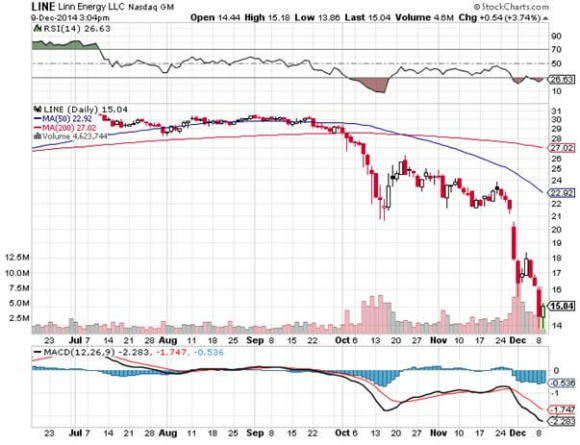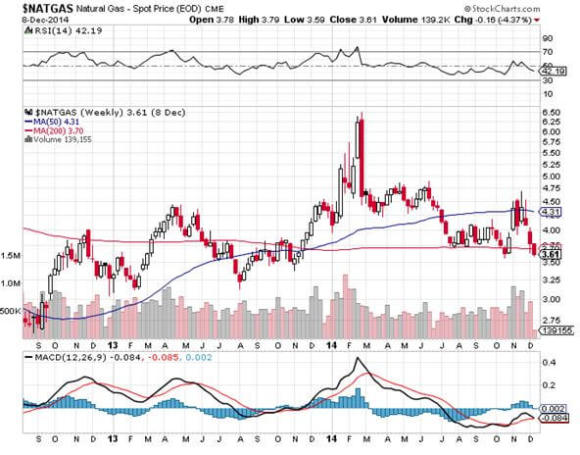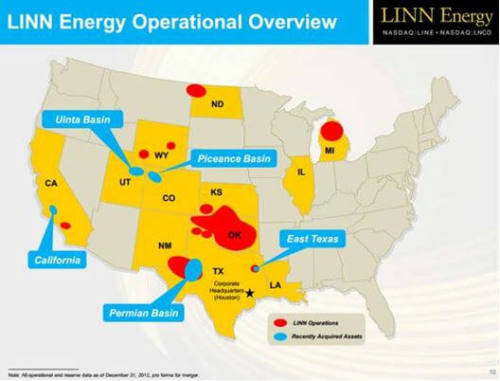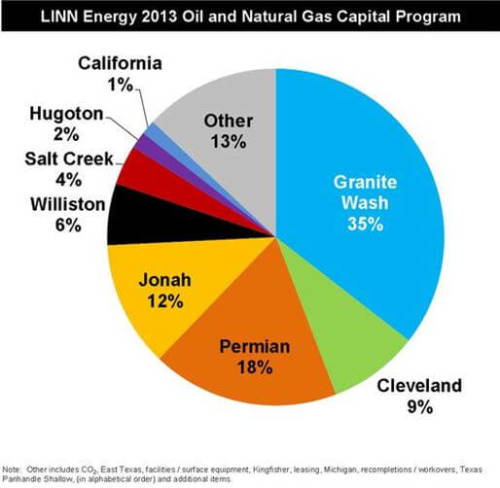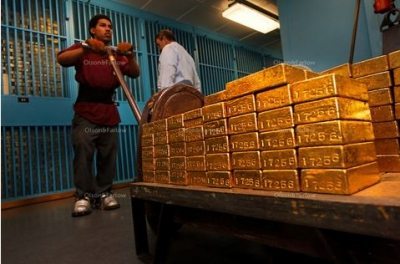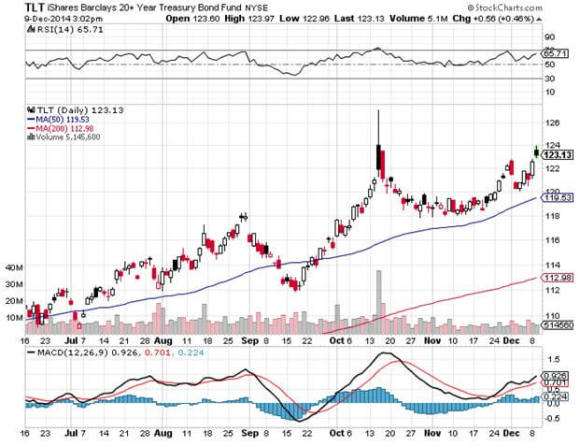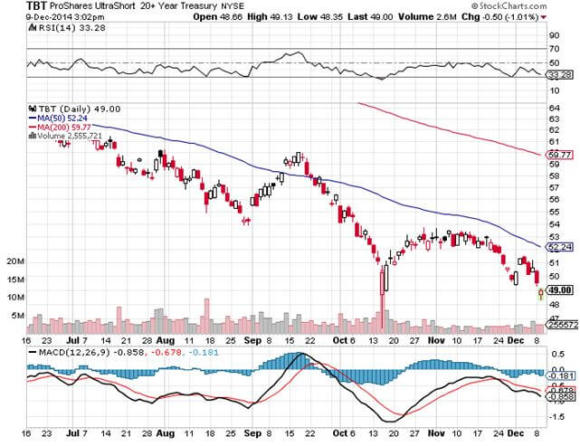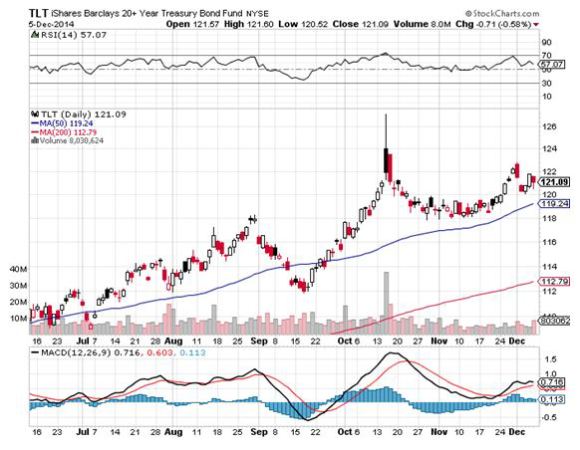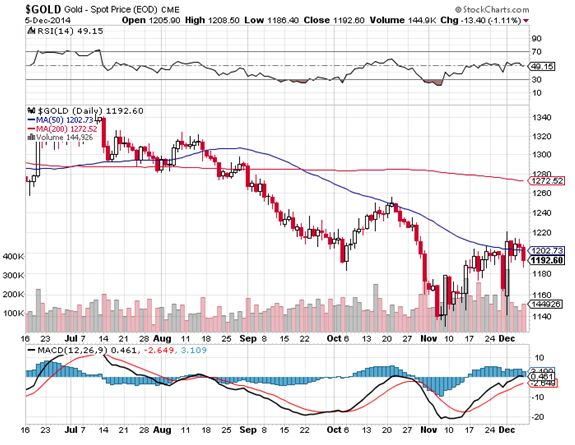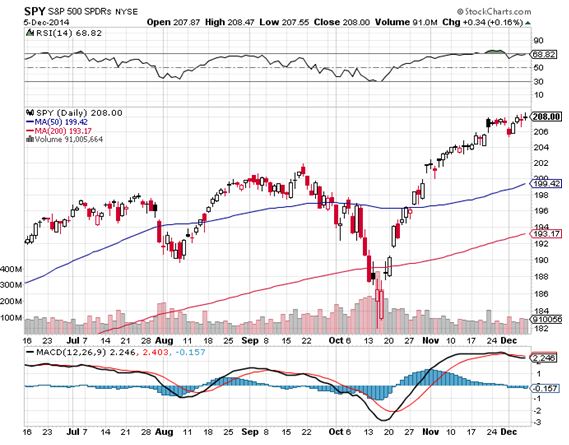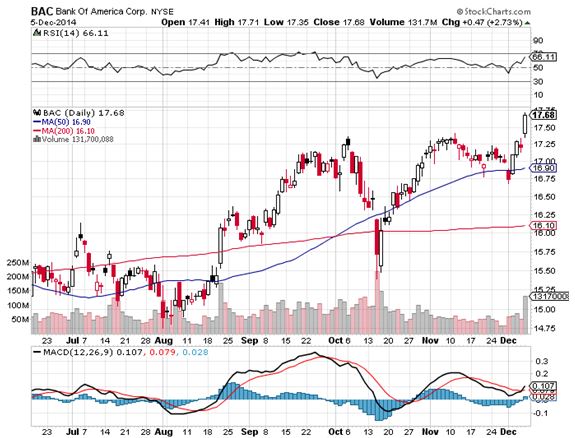Global Market Comments
December 10, 2014
Fiat Lux
Featured Trade:
(UPDATE ON LINN ENERGY), (LINE),
(THE MYSTERY OF THE MISSING $100 BILLION), (TLT),
(MY FAVORITE SECRET ECONOMIC INDICATOR)
Linn Energy, LLC (LINE)
iShares 20+ Year Treasury Bond (TLT)
After the catastrophic 25% fall in the units of Linn Energy (LINE) over the past three days, I thought I?d better take another look at the company. The company?s units have now crashed by an eye popping 55% since the May $31 high.
The units have been trading as if the company is imminently going bankrupt. The contradiction is that it clearly isn?t. This is basically a healthy company that is undergoing some volatility typical for the sector.
Is this logical or rational?
No, not at all. But when a real panic hits, you sell first, and ask questions later. That has clearly been happening in the oil patch for the past month.
At the $14 low on Monday, the units were yielding a spectacular 20.7% annualized. This is not some imaginary pie in the sky estimate. This is what the actual $0.24 monthly cash payout announced by the company as recently as December 1 works out to for holders of record as of Thursday, December 11.
Nor are these spectacular yields based on some wild leveraged bets in the financial markets. (LINE) is predominantly a natural gas company, a commodity which has seen its price go largely unchanged for the past two years, hovering above $3.50. And much of its production has already been hedged against any downside risk with offsetting positions in the futures market.
I always try to use every loss as a learning opportunity, or the lesson goes wasted, and is doomed to repetition.
The reasons above were why I shot out a quick Trade Alert last week to buy (LINN) at $16.67. It was an uncharacteristically cautious position for me. But calling bottoms in major trends is always a risky enterprise, so I went small, very small. I bought the underlying units, not the options, and then in unleveraged form.
Initially things went great, rocketing 13% right out the door. Short term, smart traders, like Mad Day Trader Jim Parker, then put in tight stop losses below. That way, he was playing with the house?s money in any further upside, and is assured against loss during any rapid reversal.
I, unfortunately was too slow to do so, and had to bear the cost of the sudden 25% drop. Remember, being right 80% of the time means that I am wrong 20% of the time. But with only a 10% position, my loss never exceeded 1.60% of my total portfolio, something I can live with, and ride out until any recovery.
My guess is that many (LINE) holders violated my ?Sleep at night rule,? lured by the hefty dividend payout into owning too many units.
Once burned, twice forewarned.
My advice to you now is ?Hang on.? You?ve already taken the hit. Don?t bail here and miss the recovery, which will probably begin in earnest next year.
Now you see it, now you don?t.
That was the question observers of international monetary flows were asking after last week?s data release from the Federal Reserve. These showed that some $104.5 billion in Treasury securities held in custody accounts were withdrawn.
It doesn?t mean that these bonds were sold. You certainly would have noticed this in the Treasury market, where a liquidation of this size could have moved prices down and yields up as much as 20 basis points. In fact prices went up and yields down during the week in question.
They were simply transferred from one custodian to another. Why this matters in an age when securities are only issued in electronic, not physical form, is beyond my pay grade.
Of course, all fingers pointed to Russia, who was thought to have made the move to avoid coming economic sanctions in the wake of their annexation of Crimea. The sanctions did come, but were primarily imposed on the oligarchs, not on governmental institutions, as a way of singling out Vladimir Putin?s political and financial backers.
Do the oligarchs own this much US government paper? Probably.
The Russians have valid concerns. The United States has seized more sovereign assets than any other country in history.
It did so against Japan and Italy, and Germany twice during WWI and WWII. Few know this, but the Bayer Company of aspirin fame in the US, is separate from Bayer in Germany, the former seized by the US and sold off as an alien asset during the Second World War. Today, the US is sitting on $100 billion worth of Iranian assets.
In the global scheme of things, this is not that big of a deal. Russia ranks only 11th among foreign holders of Treasury debt, with $139 billion, far behind China ($1.26 trillion) and Japan ($1.18 trillion). The great irony in these numbers is that they show that if the US wants to protect anyone from a Chinese attack, they have to borrow money from China to do it.
This could be part of a broader trend of cash rich countries withdrawing their savings from the US. Much was made of this when Germany asked for the return of the bulk of its gold bullion holdings held by the Federal Reserve Bank of New York at 33 Liberty Street, NY, NY last year (former Treasury Secretary Tim Geithner?s old hang out).
I?ve been in that vault. There, behind steel bars, are dozens of pallets piled high with 100 ounce gold bars, each labeled with the country of ownership. When gold reserves are transferred from country to country, they are simply carried (with white gloves to avoid friction) from one pallet to the next.
This has been the fuel for endless conspiracy theories on the internet, which over the years anticipated a dollar crash, a default of the US government, a takeover by the Trilateral Commission, or a complete collapse of the global financial system.
The reality is a little more mundane. The Fed took deposit of European gold reserves after WWII in case The Russian Army overran Western Europe. In the end, they didn?t. We had nukes, and they had none.
However, given the machinations of Putin in Crimea in recent weeks, the Germans might think about sending their gold bullion back to the New York Fed, post haste.
 Now Who Do These Belong To?
Now Who Do These Belong To?
Global Market Comments
December 9, 2014
Fiat Lux
Featured Trade:
(CHICAGO TUESDAY, DECEMBER 23 GLOBAL STRAGEGY LUNCHEON),
(TAKE A RIDE IN THE NEW SHORT JUNK ETF),
(SJB), (JNK), (CORN)
(TESTIMONIAL)
ProShares Short High Yield (SJB)
SPDR Barclays High Yield Bond ETF (JNK)
Teucrium Corn ETF (CORN)
Global Market Comments
December 8, 2014
Fiat Lux
Featured Trade:
(FRIDAY APRIL 3 HONOLULU, HAWAII STRATEGY LUNCHEON)
(THE NOVEMBER NONFARM PAYROLL REPORT IS A GAME CHANGER),
(TLT), (TBT), (SPY), (GLD), (BAC)
(THE REAL ESTATE MARKET IN 2030)
iShares 20+ Year Treasury Bond (TLT)
ProShares UltraShort 20+ Year Treasury (TBT)
SPDR S&P 500 ETF (SPY)
SPDR Gold Shares (GLD)
Bank of America Corporation (BAC)
Finally, the economy is starting to deliver the blockbuster numbers that I have been predicting all year.
The 321,000 gain in the November nonfarm payroll on Friday wasn?t just good, they were fantastic, truly of boom time proportions. It was the best report in nearly three years. The headline unemployment rate stayed at 5.8%, a seven year low.
It vindicates my ultra bullish view for the US economy of a robust 4% GDP growth rate in 2015. It also makes my own out-of-consensus $2,100 yearend target for the S&P 500 a chip shot (everybody and his brother?s target now, but certainly out-of-consensus last January).
There has been a steady drip, drip of data warning that something big was headed our way for the last several months. November auto sales a 17 million annualized rate was a key piece of the puzzle, as consumers cashed in on cheap gas prices to buy low mileage, high profit margin SUV?s. The Chrysler Jeep Cherokee, a piece of crap car if there ever was one, saw sales rocket by a mind-boggling 60%!
It reaffirms my view that the 40% collapse in the price of energy since June is not worth the 10% improvement in stock indexes we have seen so far. It justifies at least a double, probably to be spread over the next three years.
It also looks like Santa Claus will be working overtime this Christmas. Retailers are reporting a vast improvement over last year?s weather compromised sales results. A standout figure in the payroll report was the 50,000 jobs added by the sector. This is much more than just a seasonal influence, as FedEx and UPS pile on new workers.
The market impact was predictable. Treasury bond yields (TLT) spiked 10 basis points, the biggest one-day gain in four years. My position in the short Treasury ETF (TBT) saw a nice pop. Unloved gold (GLD) got slaughtered, again, cratering $25.
Stocks (SPY) didn?t see any big moves, and simply failed to give up their recent humongous gains once again. A major exception was the financials (XLF), egged on by diving bond prices. My long in Bank of America (BAC) saw another new high for the year.
All in all, it was another good day for followers of the Mad Hedge Fund Trader.
To understand how overwhelmingly positive the report was, you have to dive into the weeds. Average hourly earnings were up the most in 17 months. The September payroll report was revised upward from 256,000 to 271,000, while October was boosted from 214,000 to 243,000.
Professional and business services led the pack, up a whopping 86,000. There are serious, non minimum wage jobs. Job gains have averaged an impressive 278,000 over the last three months.
The broader U-6 unemployment rate fell to 11.4%, down from 12.7% a year ago. Most importantly, wage growth is accelerating, and hours worked are at a new cyclical high.
In view of these impressive numbers, it is unlikely that we will see any substantial pullback in share prices for the rest of 2014. For that, we will have to wait until 2015.
Global Market Comments
December 5, 2014
Fiat Lux
Featured Trade:
(CHICAGO TUESDAY, DECEMBER 23 GLOBAL STRAGEGY LUNCHEON),
(HERE IS YOUR BIG NEW YEAR TRADE),
(CU), (FCX),
(RUNNING THE SAN FRANCISCO BAY TO BREAKERS)
First Trust ISE Global Copper ETF (CU)
Freeport-McMoRan Inc. (FCX)
Legal Disclaimer
There is a very high degree of risk involved in trading. Past results are not indicative of future returns. MadHedgeFundTrader.com and all individuals affiliated with this site assume no responsibilities for your trading and investment results. The indicators, strategies, columns, articles and all other features are for educational purposes only and should not be construed as investment advice. Information for futures trading observations are obtained from sources believed to be reliable, but we do not warrant its completeness or accuracy, or warrant any results from the use of the information. Your use of the trading observations is entirely at your own risk and it is your sole responsibility to evaluate the accuracy, completeness and usefulness of the information. You must assess the risk of any trade with your broker and make your own independent decisions regarding any securities mentioned herein. Affiliates of MadHedgeFundTrader.com may have a position or effect transactions in the securities described herein (or options thereon) and/or otherwise employ trading strategies that may be consistent or inconsistent with the provided strategies.



